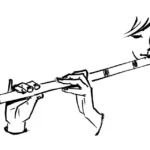Ear training is one of the most crucial skills for learning the flute or any other instrument. A musician must develop a good listening ability to understand the subtle elements of music and identify the notes. Ear training also enhances our musicality and helps us understand music better.
For a student undergoing flute training online, listening and observing the mentor is very important. This journey of ‘ear training’ starts from differentiating between the lower and higher notes. When they lift different fingers, they observe how the pitch of the notes changes. Slowly, they learn and recognise the placement of seven swars. As we practice these seven notes, we can observe the flow of swaras in various songs and tunes. We understand if the swaras used in the music are moving towards higher notes or lower notes and it also becomes the first step in flute training online.
Then the students are slowly introduced to five vikrut swaras. To play and learn the flute, understanding these twelve swaras are very vital. As we start practising these twelve swaras, we can observe the swaras and understand the notation of various tunes and songs. Once we are comfortable with these twelve notes, we can understand and play any music.
A student learning the flute must listen to a lot of music. Listening to music refines the ear further. As we listen to great artists, we understand the deeper nuances of music. We understand the subtleness of swaras, the small ornamentations and the emotions of the Ragas and tunes. When we listen and learn extensively, our ears are further tuned and we notice the finer differences in notes in various Ragas. We understand the aesthetics and mood of the Ragas. We also comprehend how a change in shrutis might completely transform the raga’s form. Even yet, one cannot fully know the Ragas and Shrutis until they study under a guru and put their knowledge into practice.
A student learning the flute can further refine the ears by continuous practice. We must be aware of what we are playing and should continuously rectify our swaras. We can only experience the swaras with practice. The most effective way to understand the swaras is the practice of long notes. When we practice Sa, the aadhara swara, continuously, we also know and understand other swaras better. We encounter the correct placements of the swaras when we play extended notes with tanpura. When we play erroneous swara, it sounds incongruous. Practising long swaras with tanpura makes us understand appropriate swaras.
Learning, listening and practising are all very vital when it comes to ear training and undergoing flute training online. We can never understand swaras or music without learning. It helps us develop our musicality and provides a solid foundation. Listening adds to the learning process and gives us an idea about the subtle elements of music. It helps us explore various forms, emotions and expressions. Practice solidifies this knowledge. We can experience the distance of the swaras only through practice. So, learning flute or any musical instrument is a continuous process of learning, listening and practising, an infinite possibility of constant learning and delving deeper into the ocean of music.
Read more: Tips to improve Your Bansuri Techniques




